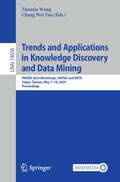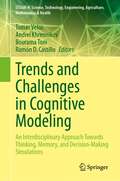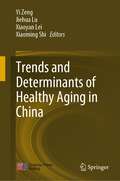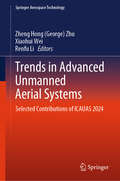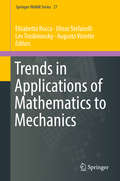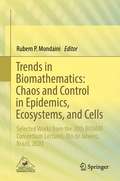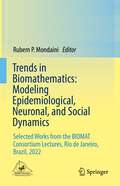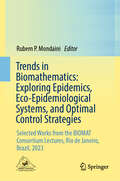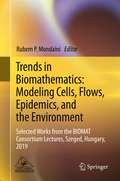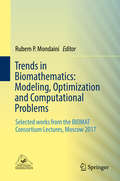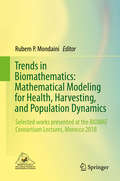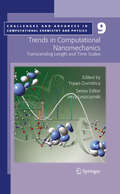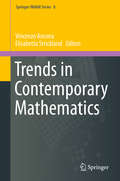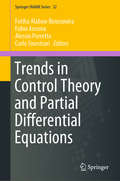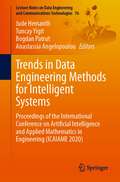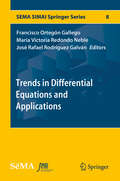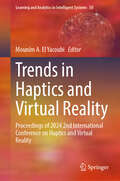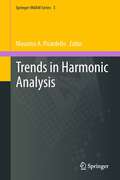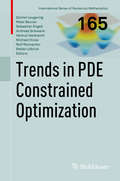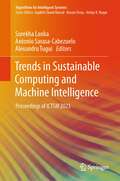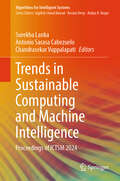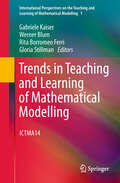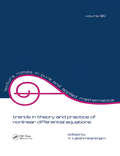- Table View
- List View
Trends and Applications in Knowledge Discovery and Data Mining: PAKDD 2024 Workshops, RAFDA and IWTA, Taipei, Taiwan, May 7–10, 2024, Proceedings (Lecture Notes in Computer Science #14658)
by Zhaoxia Wang Chang Wei TanThis book constitutes the workshops that have been held in conjunction with the 27th Pacific-Asia Conference on Knowledge Discovery and Data Mining, PAKDD 2023, which took place in Osaka, Japan, during May 25–28, 2023. For RAFDA 2024, Workshop on Research and Applications of Foundation Models for Data Mining and Affective Computing, 15 submissions have been received and 9 full papers have been accepted for publication. For IWTA 2024, International Workshop on Temporal Analytics, 4 full papers have been accepted from a total of 6 submissions.
Trends and Challenges in Cognitive Modeling: An Interdisciplinary Approach Towards Thinking, Memory, and Decision-Making Simulations (STEAM-H: Science, Technology, Engineering, Agriculture, Mathematics & Health)
by Bourama Toni Andrei Khrennikov Tomas Veloz Ramón D. CastilloThis book presents interdisciplinary research in the science of Human Cognition through mathematical and computational modeling and simulation. Featuring new approaches developed by leading experts in the field of cognitive science, it highlights the relevance and depth of this important area of social sciences and its expanding reach into the biological, physical, computational and mathematical sciences. This contributed volume compiles the most recent advancements and cutting-edge applications of cognitive modeling, employing a genuinely multidisciplinary approach to simulate thinking, memory, and decision-making. The topics covered encompass a wide range of subjects, such as Agent-based Modeling in psychological research, the Nyayasutra proof pattern, the utilization of the Pheromone Trail Algorithm for modeling Analog Memory, the theory and practical applications of Social Laser Theory, addressing the challenges of probabilistic learning in brain and behavior models, adopting a Physicalistic perspective to understand the emergence of cognition and computation, an in-depth analysis of the conjunction fallacy as a factual occurrence, exploring quantum modeling and causality in physics and its extensions, examining compositional vector semantics within spiking neural networks, delving into the realms of Optimality, Prototypes, and Bilingualism, and finally, investigating the intricate dimensionality of color perception. Given its scope and approach, the book will benefit researchers and students of computational social sciences, mathematics and its applications, quantum physics.
Trends and Determinants of Healthy Aging in China
by Yi Zeng Xiaoyan Lei Jiehua Lu Xiaoming ShiThis book studies healthy aging in China based on analyses of the datasets of eight waves of longitudinal survey in 1998-2018 with worldwide largest sample of oldest-old. It consists of four parts. The first part reports the 6th, 7th, and 8th surveys of “Chinese Longitudinal Healthy Longevity Survey” (CLHLS), with the largest sample of oldest-old aged 80+ in the world and comparable sample of young-old aged 65–79, trends and characteristics of physical health and mental health of older adults in China based on analyses of the CLHLS datasets. The second part focuses on analyses and discussions of the influencing factors of healthy aging from perspectives of families, socioeconomics and community environments. The third part reports studies on the gender and age differences in main chronic diseases’ prevalence rates, inflammation, anti-oxidation, trace elements, effects of the nutritional dietary structure and the environmental selenium on health among the older adults. The fourth part focuses on the analyses and discussions of policy recommendations to face the serious challenges of the population aging in China and the database of the eight waves of CLHLS from 1998 to 2018, which are available free of charge to scholars, practitioners and general public for scientific research and socioeconomic planning. This book is easy to read and to understand by researchers and the general public, and no special professional background is required.
Trends in Advanced Unmanned Aerial Systems: Selected Contributions of ICAUAS 2024 (Springer Aerospace Technology)
by Xiaohui Wei Renfu Li Zheng Hong George ZhuThis book presents an extensive exploration of the latest trends in Unmanned Aerial Systems (UAS) technology and the boundless opportunities they offer. Encompassing various facets of the UAS domain, including Autonomy and Control, Flight Dynamics and Control, Communication and Navigation, Sensing and Perception, Design and Simulation, Materials and Mechanics, the book is tailored for researchers, engineers, and practitioners deeply involved in the field of UAS. It delves into the intricate technicalities of UAS technology, providing profound insights and comprehensive discussions on its fundamental principles.
Trends in Applications of Mathematics to Mechanics
by Elisabetta Rocca Ulisse Stefanelli Lev Truskinovsky Augusto VisintinThis volume originates from the INDAM Symposium on Trends on Applications of Mathematics to Mechanics (STAMM), which was held at the INDAM headquarters in Rome on 5–9 September 2016. It brings together original contributions at the interface of Mathematics and Mechanics. The focus is on mathematical models of phenomena issued from various applications. These include thermomechanics of solids and gases, nematic shells, thin films, dry friction, delamination, damage, and phase-field dynamics. The papers in the volume present novel results and identify possible future developments. The book is addressed to researchers involved in Mathematics and its applications to Mechanics.
Trends in Biomathematics: Selected Works from the 20th BIOMAT Consortium Lectures, Rio de Janeiro, Brazil, 2020
by Rubem P. MondainiThis volume gathers together selected, peer-reviewed papers presented at the BIOMAT 2020 International Symposium, which was virtually held on November 1-6, 2020, with an organization staff based in Rio de Janeiro, Brazil. Topics covered in this volume include infection modeling, with an emphasis on different aspects of the COVID-19 and novel Coronavirus spread; a description of the effectiveness of quarantine measures via dynamic analysis of SLIR model; hemodynamic simulations in time-dependent domains; an optimal control model for the Ebola disease; and the co-existence of chaos and control in the context of biological models. Texts in agroforestry, economic development, and wastewater treatment processes complete this volume.Held every year since 2001, the BIOMAT International Symposium gathers together, in a single conference, researchers from Mathematics, Physics, Biology, and affine fields to promote the interdisciplinary exchange of results, ideas and techniques, promoting truly international cooperation for problem discussion. The 20th edition of the BIOMAT International Symposium has received contributions by authors from 18 countries: Algeria, Brazil, Cameroon, Canada, Chile, China (Hong Kong), Colombia, Germany, Hungary, India, Italy, Morocco, Nigeria, Russia, Senegal, South Africa, USA, and Uzbekistan. Previous BIOMAT volumes with selected works from 2017, 2018, and 2019 were also published by Springer.
Trends in Biomathematics: Selected Works from the BIOMAT Consortium Lectures, Rio de Janeiro, Brazil, 2022
by Rubem P. MondainiThis volume gathers together selected peer-reviewed works presented at the BIOMAT 2022 International Symposium, which was virtually held on November 7-11, 2022, with an organization staff based in Rio de Janeiro, Brazil. Topics touched on in this volume include infection spread in a population described by an agent-based approach; the study of gene essentiality via network-based computational modeling; stochastic models of neuronal dynamics; and the modeling of a statistical distribution of amino acids in protein domain families. The reader will also find texts in epidemic models with dynamic social distancing; with no vertical transmission; and with general incidence rates. Aspects of COVID-19 dynamics: the use of an SEIR model to analyze its spread in Brazil; the age-dependent manner of modeling its spread pattern; the impact of media awareness programs; and a web-based computational tool for Non-invasive hemodynamics evaluation of coronary stenosis are also covered. Held every year since 2001, The BIOMAT International Symposium gathers together, in a single conference, researchers from Mathematics, Physics, Biology, and affine fields to promote the interdisciplinary exchange of results, ideas and techniques, promoting truly international cooperation for problem discussion. BIOMAT volumes published from 2017 to 2021 are also available by Springer.
Trends in Biomathematics: Selected Works from the BIOMAT Consortium Lectures, Rio de Janeiro, Brazil, 2023
by Rubem P. MondainiThis volume convenes carefully selected, peer-reviewed papers presented at the BIOMAT 2023 International Symposium, which was virtually held on November 6-9, 2023, with an organization staff based in Rio de Janeiro, Brazil. In this volume, the reader will find studies on the epidemic model of the COVID-19 pandemic, aspects of risk-based testing and quarantine, as well as joint efforts in the search for the perfect vaccine. Additionally, the volume covers the influence of fear and the saturated fear cost in predator-prey dynamics, optimal control techniques applied to HPV infection and cervical cancer cells, generic epidemic models for disease propagation, discretized SIS model with no vertical transmission, dynamics of vibrio-phage interactions, and antibiotics treatment for septic arthritis. Comprehensive Reviews are also included on the applications of CHIRP ultrasound for the mathematical modeling of evaporation of nanodroplets and on Alternative Entropy Measures and their application in the studies of distributions of discrete probabilities of occurrence. These works aim to motivate Ph.D. students and new practitioners in the field of Biomathematics. Held every year since 2001, the BIOMAT International Symposium gathers together, in a single conference, researchers from Mathematics, Physics, Biology, and affine fields to foster the interdisciplinary exchange of results, ideas, and techniques, promoting truly international cooperation for problem discussion. BIOMAT volumes published from 2017 to 2022 are also available by Springer.
Trends in Biomathematics: Selected Works from the BIOMAT Consortium Lectures, Szeged, Hungary, 2019
by Rubem P. MondainiThis volume offers a collection of carefully selected, peer-reviewed papers presented at the BIOMAT 2019 International Symposium, which was held at the University of Szeged, Bolyai Institute and the Hungarian Academy of Sciences, Hungary, October 21st-25th, 2019. The topics covered in this volume include tumor and infection modeling; dynamics of co-infections; epidemic models on networks; aspects of blood circulation modeling; multidimensional modeling approach via time-frequency analysis and Edge Based Compartmental Model; and more. This book builds upon the tradition of the previous BIOMAT volumes to foster interdisciplinary research in mathematical biology for students, researchers, and professionals.Held every year since 2001, the BIOMAT International Symposium gathers together, in a single conference, researchers from Mathematics, Physics, Biology, and affine fields to promote the interdisciplinary exchange of results, ideas and techniques, promoting truly international cooperation for problem discussion. The 2019 edition of BIOMAT International Symposium received contributions by authors from 14 countries: Brazil, Cameroon, Canada, Colombia, Czech Republic, Finland, Hungary, India, Italy, Russia, Senegal, Serbia, United Kingdom and the USA. Selected papers presented at the 2017 and 2018 editions of this Symposium were also published by Springer, in the volumes "Trends in Biomathematics: Modeling, Optimization and Computational Problems" (978-3-319-91091-8) and "Trends in Biomathematics: Mathematical Modeling for Health, Harvesting, and Population Dynamics" (978-3-030-23432-4).
Trends in Biomathematics: Selected works from the BIOMAT Consortium Lectures, Moscow 2017
by Rubem P. MondainiThis book brings together carefully selected, peer-reviewed works on mathematical biology presented at the BIOMAT International Symposium on Mathematical and Computational Biology, which was held at the Institute of Numerical Mathematics, Russian Academy of Sciences, in October 2017, in Moscow. Topics covered include, but are not limited to, the evolution of spatial patterns on metapopulations, problems related to cardiovascular diseases and modeled by boundary control techniques in hemodynamics, algebraic modeling of the genetic code, and multi-step biochemical pathways. Also, new results are presented on topics like pattern recognition of probability distribution of amino acids, somitogenesis through reaction-diffusion models, mathematical modeling of infectious diseases, and many others. Experts, scientific practitioners, graduate students and professionals working in various interdisciplinary fields will find this book a rich resource for research and applications alike.
Trends in Biomathematics: Selected works presented at the BIOMAT Consortium Lectures, Morocco 2018
by Rubem P. MondainiThis volume offers a collection of carefully selected, peer-reviewed papers presented at the BIOMAT 2018 International Symposium, which was held at the University Hassan II, Morocco, from October 29th to November 2nd, 2018. The topics covered include applications of mathematical modeling in hepatitis B, HIV and Chikungunya infections; tumor cell dynamics; inflammatory processes; chemotherapeutic drug effects; and population dynamics. Also discussing the application of techniques like the generalized stochastic Milevsky-Promislov model, numerical simulations and convergence of discrete and continuous models, it is an invaluable resource on interdisciplinary research in mathematical biology for students, researchers, and professionals.Held every year since 2001, the BIOMAT International Symposium gathers together, in a single conference, researchers from Mathematics, Physics, Biology, and affine fields to promote the interdisciplinary exchange of results, ideas and techniques, promoting truly international cooperation for problem discussion. The 2018 edition of BIOMAT International Symposium received contributions by authors from seventeen countries: Algeria, Brazil, Cameroon, Canada, Chad, Colombia, France, Germany, Hungary, Italy, Mali, Morocco, Nigeria, Poland, Portugal, Russia, and Senegal. Selected papers presented at the 2017 edition of this Symposium were also published by Springer, in the volume “Trends in Biomathematics: Modeling, Optimization and Computational Problems” (978-3-319-91091-8).
Trends in Computational Nanomechanics
by Traian DumitricaTrends in Computational Nanomechanics reviews recent advances in analytical and computational modeling frameworks to describe the mechanics of materials on scales ranging from the atomistic, through the microstructure or transitional, and up to the continuum. The book presents new approaches in the theory of nanosystems, recent developments in theoretical and computational methods for studying problems in which multiple length and/or time scales must be simultaneously resolved, as well as example applications in nanomechanics. This title will be a useful tool of reference for professionals, graduates and undergraduates interested in Computational Chemistry and Physics, Materials Science, Nanotechnology.
Trends in Contemporary Mathematics
by Elisabetta Strickland Vincenzo AnconaThe topics faced in this book cover a large spectrum of current trends in mathematics, such as Shimura varieties and the Lang lands program, zonotopal combinatorics, non linear potential theory, variational methods in imaging, Riemann holonomy and algebraic geometry, mathematical problems arising in kinetic theory, Boltzmann systems, Pell's equations in polynomials, deformation theory in non commutative algebras. This work contains a selection of contributions written by international leading mathematicians who were speakers at the "INdAM Day", an initiative born in 2004 to present the most recent developments in contemporary mathematics.
Trends in Control Theory and Partial Differential Equations (Springer INdAM Series #32)
by Fatiha Alabau-Boussouira Fabio Ancona Carlo Sinestrari Alessio PorrettaThis book presents cutting-edge contributions in the areas of control theory and partial differential equations. Over the decades, control theory has had deep and fruitful interactions with the theory of partial differential equations (PDEs). Well-known examples are the study of the generalized solutions of Hamilton-Jacobi-Bellman equations arising in deterministic and stochastic optimal control and the development of modern analytical tools to study the controllability of infinite dimensional systems governed by PDEs. In the present volume, leading experts provide an up-to-date overview of the connections between these two vast fields of mathematics. Topics addressed include regularity of the value function associated to finite dimensional control systems, controllability and observability for PDEs, and asymptotic analysis of multiagent systems. The book will be of interest for both researchers and graduate students working in these areas.
Trends in Data Engineering Methods for Intelligent Systems
by Jude Hemanth Bogdan Patrut Tuncay Yigit Anastassia AngelopoulouThis book briefly covers internationally contributed chapters with artificial intelligence and applied mathematics-oriented background-details. Nowadays, the world is under attack of intelligent systems covering all fields to make them practical and meaningful for humans. In this sense, this edited book provides the most recent research on use of engineering capabilities for developing intelligent systems. The chapters are a collection from the works presented at the 2nd International Conference on Artificial Intelligence and Applied Mathematics in Engineering held within 09-10-11 October 2020 at the Antalya, Manavgat (Turkey). The target audience of the book covers scientists, experts, M.Sc. and Ph.D. students, post-docs, and anyone interested in intelligent systems and their usage in different problem domains. The book is suitable to be used as a reference work in the courses associated with artificial intelligence and applied mathematics.
Trends in Differential Equations and Applications
by Francisco Ortegón Gallego María Victoria Redondo Neble José Rafael Rodríguez GalvánThis work collects the most important results presented at the Congress on Differential Equations and Applications/Congress on Applied Mathematics (CEDYA/CMA) in Cádiz (Spain) in 2015. It supports further research in differential equations, numerical analysis, mechanics, control and optimization. In particular, it helps readers gain an overview of specific problems of interest in the current mathematical research related to different branches of applied mathematics. This includes the analysis of nonlinear partial differential equations, exact solutions techniques for ordinary differential equations, numerical analysis and numerical simulation of some models arising in experimental sciences and engineering, control and optimization, and also trending topics on numerical linear Algebra, dynamical systems, and applied mathematics for Industry. This volume is mainly addressed to any researcher interested in the applications of mathematics, especially in any subject mentioned above. It may be also useful to PhD students in applied mathematics, engineering or experimental sciences.
Trends in Haptics and Virtual Reality: Proceedings of 2024 2nd International Conference on Haptics and Virtual Reality (Learning and Analytics in Intelligent Systems #50)
by Mounîm A. El YacoubiThis book encompasses the collective wisdom and groundbreaking insights shared on 2024 2nd International Conference on Haptics and Virtual Reality (ICHVR 2024). It delves into the intricate field of Haptics and Virtual Reality, providing novel insights and profound discussions on its fundamental principles and application. It is tailored for researchers, engineers, and practitioners deeply involved in the field of Haptics and Virtual Reality. Comparing to last edition, this book mainly presents real-world examples of how Haptics and Virtual Reality technology is being used today.
Trends in Harmonic Analysis
by Massimo A. PicardelloThis book illustrates the wide range of research subjects developed by the Italian research group in harmonic analysis, originally started by Alessandro Figà-Talamanca, to whom it is dedicated in the occasion of his retirement. In particular, it outlines some of the impressive ramifications of the mathematical developments that began when Figà-Talamanca brought the study of harmonic analysis to Italy; the research group that he nurtured has now expanded to cover many areas. Therefore the book is addressed not only to experts in harmonic analysis, summability of Fourier series and singular integrals, but also in potential theory, symmetric spaces, analysis and partial differential equations on Riemannian manifolds, analysis on graphs, trees, buildings and discrete groups, Lie groups and Lie algebras, and even in far-reaching applications as for instance cellular automata and signal processing (low-discrepancy sampling, Gaussian noise).
Trends in PDE Constrained Optimization
by Peter Benner Michael Hinze Rolf Rannacher Günter Leugering Sebastian Engell Andreas Griewank Helmut Harbrecht Stefan UlbrichOptimization problems subject to constraints governed by partial differential equations (PDEs) are among the most challenging problems in the context of industrial, economical and medical applications. Almost the entire range of problems in this field of research was studied and further explored as part of the Deutsche Forschungsgemeinschaft (DFG) priority program 1253 on "Optimization with Partial Differential Equations" from 2006 to 2013. The investigations were motivated by the fascinating potential applications and challenging mathematical problems that arise in the field of PDE constrained optimization. New analytic and algorithmic paradigms have been developed, implemented and validated in the context of real-world applications. In this special volume, contributions from more than fifteen German universities combine the results of this interdisciplinary program with a focus on applied mathematics. The book is divided into five sections on "Constrained Optimization, Identification and Control", "Shape and Topology Optimization", "Adaptivity and Model Reduction", "Discretization: Concepts and Analysis" and "Applications". Peer-reviewed research articles present the most recent results in the field of PDE constrained optimization and control problems. Informative survey articles give an overview of topics that set sustainable trends for future research. This makes this special volume interesting not only for mathematicians, but also for engineers and for natural and medical scientists working on processes that can be modeled by PDEs.
Trends in Sustainable Computing and Machine Intelligence: Proceedings of ICTSM 2023 (Algorithms for Intelligent Systems)
by Surekha Lanka Antonio Sarasa-Cabezuelo Alexandru TuguiThe book is a collection of best selected research papers presented at International Conference on Trends in Sustainable Computing and Machine Intelligence (ICTSM 2023) organized by Stamford International University, Bangkok, Thailand, during October 5–6, 2023. The book includes original research by researchers working in the field of machine learning. The book covers important topics like decision support systems, neural networks and applications, machine learning, natural language processing, automated problem solving, AI and evolutionary algorithms, intelligent information systems, computational intelligence, computer vision and image processing, cognitive and biologically inspired vision, soft computing and applications, hybrid intelligent systems, distributed computing, pattern recognition and analysis, ubiquitous and high-performance computing, security, trust and privacy, big data for sustainable computing, and energy-aware machine learning.
Trends in Sustainable Computing and Machine Intelligence: Proceedings of ICTSM 2024 (Algorithms for Intelligent Systems)
by Chandrasekar Vuppalapati Surekha Lanka Antonio Sarasa CabezueloThis book is a collection of best selected research papers presented at International Conference on Trends in Sustainable Computing and Machine Intelligence (ICTSM 2024) organized by Stamford International University, Bangkok, Thailand, during September 12–13, 2024. The book includes original research by researchers working in the field of machine learning. The book covers important topics like decision support systems, neural networks and applications, machine learning, natural language processing, automated problem solving, AI and evolutionary algorithms, intelligent information systems, computational intelligence, computer vision and image processing, cognitive and biologically inspired vision, soft computing and applications, hybrid intelligent systems, distributed computing, pattern recognition and analysis, ubiquitous and high-performance computing, security, trust and privacy, big data for sustainable computing, and energy-aware machine learning.
Trends in Teaching and Learning of Mathematical Modelling
by Gabriele Kaiser Werner Blum Rita Borromeo Ferri Gloria StillmanThis book contains suggestions for and reflections on the teaching, learning and assessing of mathematical modelling and applications in a rapidly changing world, including teaching and learning environments. It addresses all levels of education from universities and technical colleges to secondary and primary schools. Sponsored by the International Community of Teachers of Mathematical Modelling and Applications (ICTMA), it reflects recent ideas and methods contributed by specialists from 30 countries in Africa, the Americas, Asia, Australia and Europe. Inspired by contributions to the Fourteenth Conference on the Teaching of Mathematical Modelling and Applications (ICTMA14) in Hamburg, 2009, the book describes the latest trends in the teaching and learning of mathematical modelling at school and university including teacher education. The broad and versatile range of topics will stress the international state-of-the-art on the following issues: Theoretical reflections on the teaching and learning of modelling Modelling competencies Cognitive perspectives on modelling Modelling examples for all educational levels Practice of modelling in school and at university level Practices in Engineering and Applications
Trends in Theory and Practice of Nonlinear Differential Equations (Lecture Notes In Pure And Applied Mathematics Ser. #90)
by LakshmikanthamThis book is based on an International Conference on Trends in Theory and Practice of Nonlinear Differential Equations held at The University of Texas at Arlington. It aims to feature recent trends in theory and practice of nonlinear differential equations.
Trends in the Draw of Americans to Foreign Terrorist Organizations from 9/11 to Today
by Eric Robinson Nathan Chandler Heather J. WilliamsThe Islamic State of Iraq and the Levant (ISIL) has recently been more successful than al Qaeda in gaining U.S. terrorist recruits. The authors undertake a demographic profile of individuals drawn to foreign terrorist organizations and find that the affiliates average terrorists recruited by ISIL is younger, less educated, and more likely to be African American/black or Caucasian/white and a U.S.-born citizen.
Trends of Artificial Intelligence and Big Data for E-Health (Integrated Science #9)
by Safwan Halabi Houneida Sakly Kristen Yeom Mourad Said Jayne Seekins Moncef TaginaThis book aims to present the impact of Artificial Intelligence (AI) and Big Data in healthcare for medical decision making and data analysis in myriad fields including Radiology, Radiomics, Radiogenomics, Oncology, Pharmacology, COVID-19 prognosis, Cardiac imaging, Neuroradiology, Psychiatry and others. This will include topics such as Artificial Intelligence of Thing (AIOT), Explainable Artificial Intelligence (XAI), Distributed learning, Blockchain of Internet of Things (BIOT), Cybersecurity, and Internet of (Medical) Things (IoTs). Healthcare providers will learn how to leverage Big Data analytics and AI as methodology for accurate analysis based on their clinical data repositories and clinical decision support. The capacity to recognize patterns and transform large amounts of data into usable information for precision medicine assists healthcare professionals in achieving these objectives. Intelligent Health has the potential to monitor patients at risk with underlying conditions and track their progress during therapy. Some of the greatest challenges in using these technologies are based on legal and ethical concerns of using medical data and adequately representing and servicing disparate patient populations. One major potential benefit of this technology is to make health systems more sustainable and standardized. Privacy and data security, establishing protocols, appropriate governance, and improving technologies will be among the crucial priorities for Digital Transformation in Healthcare.
